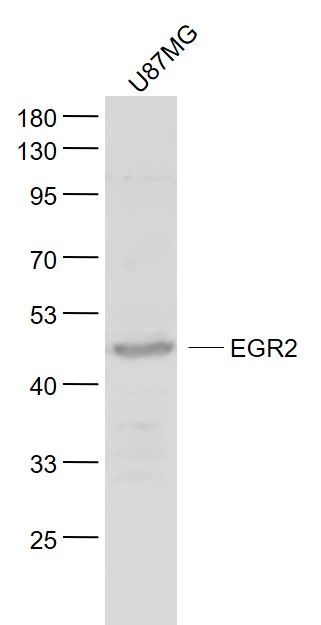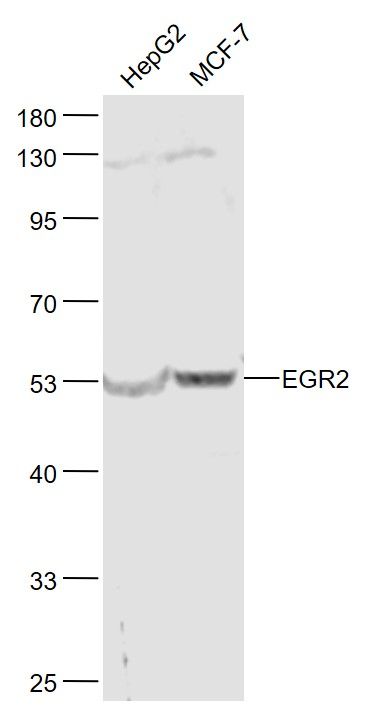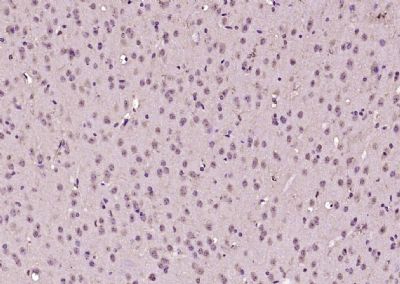EGR2 Polyclonal Antibody
Purified Rabbit Polyclonal Antibody (Pab)
- 产品详情
- 实验流程
Application
| WB, IHC-P, IHC-F, IF, E |
|---|---|
| Primary Accession | P11161 |
| Reactivity | Rat |
| Host | Rabbit |
| Clonality | Polyclonal |
| Calculated MW | 50302 Da |
| Physical State | Liquid |
| Immunogen | KLH conjugated synthetic peptide derived from human EGR2 |
| Epitope Specificity | 351-450/476 |
| Purity | affinity purified by Protein A |
| Buffer | 0.01M TBS (pH7.4) with 1% BSA, 0.02% Proclin300 and 50% Glycerol. |
| SUBCELLULAR LOCATION | Nucleus. |
| SIMILARITY | Belongs to the EGR C2H2-type zinc-finger protein family. Contains 3 C2H2-type zinc fingers. |
| SUBUNIT | Interacts with HCFC1. Interacts with WWP2. Interacts with UBC9. |
| Post-translational modifications | Ubiquitinated by WWP2 leading to proteasomal degradation (By similarity). |
| DISEASE | Defects in EGR2 are a cause of congenital hypomyelination neuropathy (CHN) [MIM:605253]. Inheritance can be autosomal dominant or recessive. Recessive CHN is also known as Charcot-Marie-Tooth disease type 4E (CMT4E). CHN is characterized clinically by early onset of hypotonia, areflexia, distal muscle weakness, and very slow nerve conduction velocities.Defects in EGR2 are a cause of Charcot-Marie-Tooth disease type 1D (CMT1D) [MIM:607678]. CMT1D is a form of Charcot-Marie-Tooth disease, the most common inherited disorder of the peripheral nervous system. Charcot-Marie-Tooth disease is classified in two main groups on the basis of electrophysiologic properties and histopathology: primary peripheral demyelinating neuropathy or CMT1, and primary peripheral axonal neuropathy or CMT2. Neuropathies of the CMT1 group are characterized by severely reduced nerve conduction velocities (less than 38 m/sec), segmental demyelination and remyelination with onion bulb formations on nerve biopsy, slowly progressive distal muscle atrophy and weakness, absent deep tendon reflexes, and hollow feet. Defects in EGR2 are a cause of Dejerine-Sottas syndrome (DSS) [MIM:145900]; also known as Dejerine-Sottas neuropathy (DSN) or hereditary motor and sensory neuropathy III (HMSN3). DSS is a severe degenerating neuropathy of the demyelinating Charcot-Marie-Tooth disease category, with onset by age 2 years. DSS is characterized by motor and sensory neuropathy with very slow nerve conduction velocities, increased cerebrospinal fluid protein concentrations, hypertrophic nerve changes, delayed age of walking as well as areflexia. There are both autosomal dominant and autosomal recessive forms of Dejerine-Sottas syndrome. |
| Important Note | This product as supplied is intended for research use only, not for use in human, therapeutic or diagnostic applications. |
| Background Descriptions | Egr proteins function in transcription regulatory activities surrounding cellular growth, differentiation and function. The deduced amino acid sequences of human Egr-2 and mouse Egr-1 are 92% identical in the zinc finger region but show no homology elsewhere. Egr-2 is a sequence-specific DNA-binding transcription factor that binds two specific DNA sites located in the promoter region of HoxA4 and localizes to the nucleus. Defects in the Egr-2 protein are a cause of congenital hypomyelination neuropathy (CHN). CHN is characterized clinically by early onset of hypotonia, areflexia, distal muscle weakness and very slow nerve conduction velocities. Mutations in the gene that encodes Egr-2 (EGR2) also cause Dejerine-Sottas syndrome (DSS), which is also known as Dejerine-Sottas neuropathy (DSN) or hereditary motor and sensory neuropathy III (HMSN3). DSS patients exhibit severe early onset motor and sensory neuropathy with very slow nerve conduction velocities and elevated cerebrospinal fluid protein concentrations. |
| Gene ID | 1959 |
|---|---|
| Other Names | E3 SUMO-protein ligase EGR2, 2.3.2.-, AT591, E3 SUMO-protein transferase ERG2, Early growth response protein 2, EGR-2, Zinc finger protein Krox-20, EGR2, KROX20 |
| Dilution | WB=1:500-2000,IHC-P=1:100-500,IHC-F=1:100-500,IF=1:50-200,ELISA=1:5000-10000 |
| Format | 0.01M TBS(pH7.4) with 1% BSA, 0.09% (W/V) sodium azide and 50% Glyce |
| Storage | Store at -20 °C for one year. Avoid repeated freeze/thaw cycles. When reconstituted in sterile pH 7.4 0.01M PBS or diluent of antibody the antibody is stable for at least two weeks at 2-4 °C. |
| Name | EGR2 |
|---|---|
| Synonyms | KROX20 |
| Function | Sequence-specific DNA-binding transcription factor (PubMed:17717711). Plays a role in hindbrain segmentation by regulating the expression of a subset of homeobox containing genes and in Schwann cell myelination by regulating the expression of genes involved in the formation and maintenance of myelin (By similarity). Binds to two EGR2- consensus sites EGR2A (5'-CTGTAGGAG-3') and EGR2B (5'-ATGTAGGTG-3') in the HOXB3 enhancer and promotes HOXB3 transcriptional activation (By similarity). Binds to specific DNA sites located in the promoter region of HOXA4, HOXB2 and ERBB2 (By similarity). Regulates hindbrain segmentation by controlling the expression of Hox genes, such as HOXA4, HOXB3 and HOXB2, and thereby specifying odd and even rhombomeres (By similarity). Promotes the expression of HOXB3 in the rhombomere r5 in the hindbrain (By similarity). Regulates myelination in the peripheral nervous system after birth, possibly by regulating the expression of myelin proteins, such as MPZ, and by promoting the differentiation of Schwann cells (By similarity). Involved in the development of the jaw openener musculature, probably by playing a role in its innervation through trigeminal motor neurons (By similarity). May play a role in adipogenesis, possibly by regulating the expression of CEBPB (By similarity). |
| Cellular Location | Nucleus {ECO:0000250|UniProtKB:P08152}. |
Research Areas
For Research Use Only. Not For Use In Diagnostic Procedures.
Application Protocols
Provided below are standard protocols that you may find useful for product applications.
终于等到您。ABCEPTA(百远生物)抗体产品。
点击下方“我要评价 ”按钮提交您的反馈信息,您的反馈和评价是我们最宝贵的财富之一,
我们将在1-3个工作日内处理您的反馈信息。
如有疑问,联系:0512-88856768 tech-china@abcepta.com.
¥ 1,500.00
Cat# AP58977























 癌症的基本特征包括细胞增殖、血管生成、迁移、凋亡逃避机制和细胞永生等。找到癌症发生过程中这些通路的关键标记物和对应的抗体用于检测至关重要。
癌症的基本特征包括细胞增殖、血管生成、迁移、凋亡逃避机制和细胞永生等。找到癌症发生过程中这些通路的关键标记物和对应的抗体用于检测至关重要。 为您推荐一个泛素化位点预测神器——泛素化分析工具,可以为您的蛋白的泛素化位点作出预测和评分。
为您推荐一个泛素化位点预测神器——泛素化分析工具,可以为您的蛋白的泛素化位点作出预测和评分。 细胞自噬受体图形绘图工具为你的蛋白的细胞受体结合位点作出预测和评分,识别结合到自噬通路中的蛋白是非常重要的,便于让我们理解自噬在正常生理、病理过程中的作用,如发育、细胞分化、神经退化性疾病、压力条件下、感染和癌症。
细胞自噬受体图形绘图工具为你的蛋白的细胞受体结合位点作出预测和评分,识别结合到自噬通路中的蛋白是非常重要的,便于让我们理解自噬在正常生理、病理过程中的作用,如发育、细胞分化、神经退化性疾病、压力条件下、感染和癌症。








